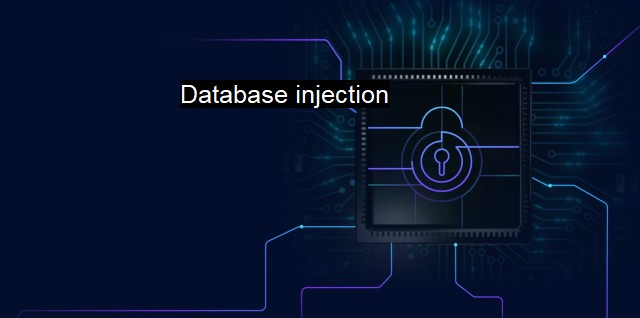What is Database injection?
Threats to Confidentiality: Understanding Database Injection Attacks and Their Impact on Cybersecurity
Database injection, commonly known as SQL injection, is a cyber-attack technique used by hackers to manipulate the SQL statements that a web application or service executes. These attacks aim to exploit security vulnerabilities in an application's software and are extensively used to steal, manipulate, or delete data stored in databases. The term "injection" refers to the fact that harmful SQL code is injected into data that is then processed by the application.Understanding database injection is critically important. Web applications and services frequently interact with databases to store, retrieve, and manipulate data. In these cases, input fields form part of SQL queries that are executed in the database through the application. In an unprotected system, a hacker can use these fields to input malicious text that gets interpolated (or 'injected') into a SQL query, and results in unexpected behavior when executed. Various cyber threats such as data theft, data loss, and unauthorized access manifest through database injections.
The impact of database injection varies depending on the intentions of the attacker and the vulnerability of the system. An attacker might exploit a vulnerability to read sensitive data from a database, modify or delete data, execute administration operations on the database such as shutting down the Database Management System (DBMS), recover contents of a given file present on the DBMS file system, and in some cases, issue commands directly to the operating system.
To illustrate how a database injection works, consider an example where a login page checks the credentials (username and password) against the records from a database. If the SQL query for such an operation is not correctly bound and sanitized, an attacker might input a carefully constructed string in the username that changes the logic of the SQL query to dishonor the password check and grants them access to the application.
The consequences of such attacks can be catastrophic – breaches of confidentiality, integrity, availability of data depending upon the nature of the successful injection attack. Large corporations, online retailers, and even governmental organizations have fallen victim to such attacks, leading to sensitive data exposure like credit card information, personal details, classified data, and sometimes even the entire database.
In the context of antivirus software, a comprehensive approach that goes beyond traditional signature-based detection is needed to tackle database injections. Antivirus solutions can monitor the behavior of applications and databases to identify and block suspicious activity. they can help to quarantine detected threats, making it easier to track, investigate, and, if necessary, remediate.
Protection against database injection attacks primarily lies in the application of good coding practices to sanitize inputs and correctly bind SQL queries, regular updates and patching of both the web applications and the databases, using web application firewalls, regular and tested data backups, limiting privileges assigned to applications, web services and regularly educating and updating the development, operations and security teams about the potential security threats and vulnerabilities related to database interactions.
Database injection is a prevalent and potent method for cyber-attack that directly threatens the security of any online data-dependent businesses. Awareness about these attacks in the context of cybersecurity and antivirus is crucial for technology-dependent firms and individuals to navigate the digital domain securely. Defense mechanisms, like using secure coding practices, robust antivirus software, vigilant monitoring of systems, and basic knowledge about potential threats, can significantly minimize the damaging effects of database injection.

Database injection FAQs
What is database injection?
Database injection, also known as SQL injection, is a type of cybersecurity attack where an attacker adds malicious code to a legitimate SQL statement in a database-driven application, allowing them to extract sensitive information or even take control of the database.How does database injection occur?
Database injection occurs when an attacker inputs malicious SQL code into a web application's input fields, which are then processed by the application's database without proper validation. This can happen due to poorly designed code, lack of input validation, or insufficient user input sanitation.What are the consequences of a successful database injection attack?
The consequences of a successful database injection attack can be severe. Attackers can steal sensitive information, manipulate or destroy data, and gain unauthorized access to the system. This can result in financial loss, reputational damage, and legal repercussions.How can I protect myself from database injection attacks?
To protect against database injection attacks, it is essential to ensure that all input fields are validated and sanitized properly. User input should be checked for malicious code or characters, and code should be designed to prevent unauthorized access to the database. Using prepared statements and parameterized queries can also help protect against database injection. Additionally, keeping your antivirus software up-to-date and using a firewall for added protection can also help prevent attacks.| | A | | | B | | | C | | | D | | | E | | | F | | | G | | | H | | | I | | | J | | | K | | | L | | | M | |
| | N | | | O | | | P | | | Q | | | R | | | S | | | T | | | U | | | V | | | W | | | X | | | Y | | | Z | |
| | 1 | | | 2 | | | 3 | | | 4 | | | 7 | | | 8 | | |||||||